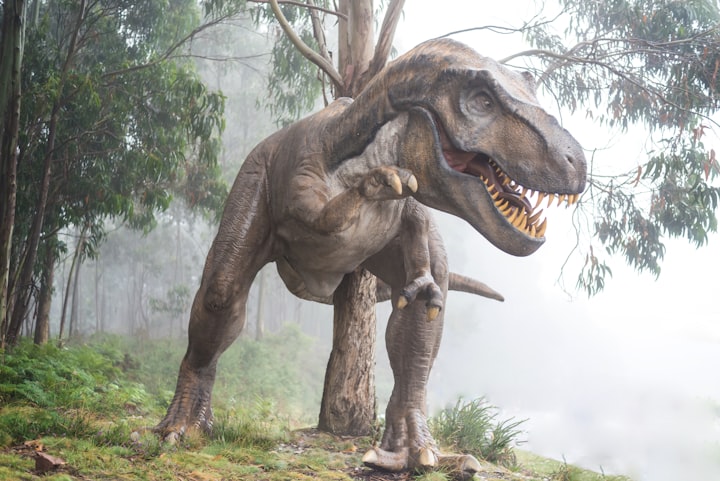Dinosaurs: Marvels of Prehistoric Earth
Dinosaurs mystery

Title: Dinosaurs: Marvels of Prehistoric Earth
Introduction:
Dinosaurs, the colossal creatures that once roamed the Earth, continue to captivate our imaginations with their immense size, ferocious appearance, and mysterious extinction. From the towering Brachiosaurus to the swift Velociraptor, these prehistoric reptiles have left an indelible mark on our planet's history and continue to fascinate scientists and enthusiasts alike. In this essay, we will explore the world of dinosaurs, from their origins and diversity to their eventual extinction and enduring legacy.
Origins and Diversity:
Dinosaurs first appeared during the Mesozoic Era, approximately 230 million years ago, and quickly diversified to inhabit nearly every corner of the globe. They ranged in size from small, chicken-sized creatures to giants weighing tens of tons. Dinosaurs were incredibly diverse, with species adapted to various habitats, diets, and lifestyles. Some were fearsome predators, equipped with sharp teeth and claws, while others were peaceful herbivores, feeding on vegetation with specialized beaks and teeth. The diversity of dinosaurs is evident in the fossil record, which reveals a staggering array of shapes, sizes, and adaptations.
Anatomy and Adaptations:
Dinosaurs were marvels of evolution, possessing a wide range of anatomical features and adaptations that allowed them to thrive in different environments. Their skeletal structure, characterized by hollow bones, provided strength while reducing weight, enabling some dinosaurs to reach enormous sizes without being weighed down. Many dinosaurs walked on two legs, while others walked on four, and some were even capable of flight. Their skulls varied in shape and size, reflecting differences in diet and feeding behavior. Some dinosaurs had elaborate crests or horns used for display or defense, while others had powerful jaws lined with sharp teeth for hunting or grazing.
Behavior and Ecology:
Dinosaurs exhibited a diverse range of behaviors, from elaborate courtship displays to complex social structures. Fossil evidence suggests that some dinosaurs lived in herds or packs, while others were solitary hunters or scavengers. Many dinosaurs cared for their young, building nests and laying eggs to ensure the survival of the next generation. They occupied a variety of habitats, including forests, plains, deserts, and wetlands, and their interactions with other organisms shaped ecosystems across the globe. Some dinosaurs were apex predators, exerting top-down control over food webs, while others played important roles as herbivores, shaping plant communities through grazing and browsing.
Extinction and Legacy:
Despite their remarkable success, dinosaurs met a catastrophic end approximately 66 million years ago, during the Cretaceous-Paleogene extinction event. This mass extinction, likely triggered by a combination of factors including volcanic activity, asteroid impact, and climate change, wiped out the non-avian dinosaurs along with many other forms of life. However, some dinosaur descendants, namely birds, survived and continue to thrive to this day. The legacy of dinosaurs lives on in the form of modern birds, as well as in the fossils and scientific discoveries that continue to shed light on their remarkable history.
Evolutionary Significance:
Dinosaurs represent a critical chapter in the evolutionary history of life on Earth. Their rise to dominance during the Mesozoic Era and subsequent extinction paved the way for the diversification of mammals and the eventual emergence of humans. Studying dinosaurs provides valuable insights into evolutionary processes, including adaptation, speciation, and extinction, and helps us understand the broader patterns of life's history on our planet.
Paleoecology and Paleoenvironments:
Dinosaurs inhabited a wide range of ecosystems, from lush tropical forests to arid desert plains. By studying dinosaur fossils and their associated sedimentary deposits, paleontologists can reconstruct ancient environments and climates, providing valuable information about Earth's past conditions. This research enhances our understanding of paleoecology and helps us predict how modern ecosystems may respond to environmental change.
Cultural Impact:
Dinosaurs have captured the imagination of people around the world and have become iconic symbols in popular culture. They have appeared in countless books, movies, television shows, and video games, inspiring awe and wonder in audiences of all ages. Dinosaurs also play a significant role in education, serving as engaging subjects for science education and fostering an interest in paleontology and natural history among students.
Scientific Methods and Techniques:
Studying dinosaurs requires a diverse array of scientific methods and techniques, including fieldwork, laboratory analysis, and computational modeling. Paleontologists use excavation tools, mapping techniques, and stratigraphic principles to uncover and document dinosaur fossils. In the laboratory, they employ microscopy, CT scanning, and geochemical analysis to study fossilized bones, teeth, and tissues. Advances in technology, such as 3D scanning and virtual reality, have revolutionized the study of dinosaurs, allowing researchers to visualize and analyze fossils in unprecedented detail.
Conservation and Preservation:
Dinosaur fossils are valuable scientific resources that provide critical information about Earth's history and biodiversity. Efforts to protect dinosaur fossils and thier associated habitats are essential for preserving these valuable records for future generations. National parks, fossil sites, and museums play a vital role in conservation efforts, providing opportunities for education, research, and public outreach. By safeguarding dinosaur fossils, we can ensure that they remain accessible for scientific study and inspire future generations of scientists and enthusiasts.
Conclusion:
Dinosaurs are among the most iconic and intriguing creatures to have ever lived, capturing our imagination with their ancient majesty and mysterious demise. Through the study of fossils and scientific research, we continue to uncover new insights into the world of dinosaurs, revealing the incredible diversity, adaptations, and behaviors of these prehistoric reptiles. While they may be gone from the Earth, dinosaurs remain a source of fascination and wonder, inspiring generations of scientists, artists, and enthusiasts to explore the depths of our planet's past.





Comments
There are no comments for this story
Be the first to respond and start the conversation.